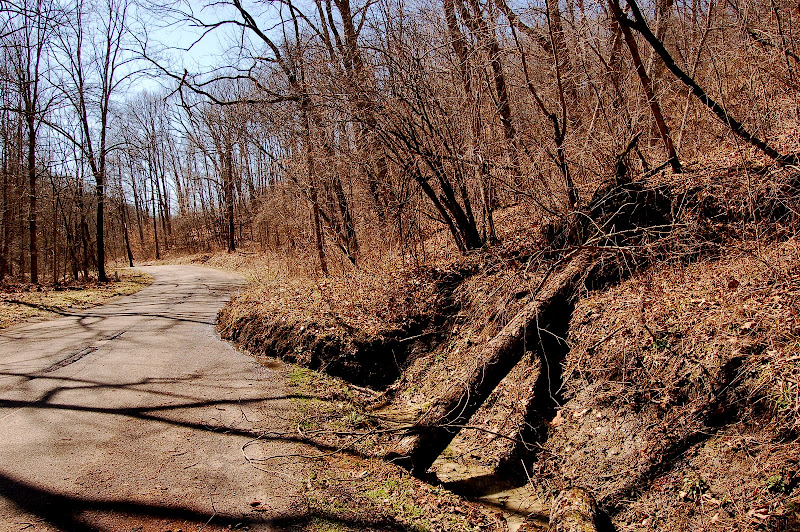
The view looking northeast. The water in the foreground is some minor flooding, presumably a by-product of the slip. There's a ditch that normally runs alongside the road to the left, and that ditch has been blocked by this clump of hillside that's suddenly in the road.

Here's the view from the opposite direction. It's far enough into the road that 2 cars can no longer pass at this point in the road, but it had not reached the center line - not yet, anyway. You'll notice a downed tree on the right side of the photo. If you look closely, you'll see that it became completely uprooted. Dave got home before I did the previous day, and that tree was blocking the road at that time (he had to drive around it).
It was difficult for me to give a good depiction of the scale of things here, but I would estimate that the slip originated 20 feet back into the hillside, and the width of the slip at it's widest point is probably also about 20 feet. That sounds like a lot of earth to be crumbling out into the road, but it's probably only the top 6 inches or so of soil that actually did the slipping (again, this is all pure estimation on my part). The tree that fell across the road was, as best as I could tell, rooted right at the edge of the slipped soil. I was amazed at the number of small trees within the area of the slipped soil that seemed to remain intact and unaffected by this movement of earth. The trees on the hillside just behind the slip zone were not in such good shape, though.

See all the trees leaning to the right? Those are all trees who had their root systems compromised, and probably even pulled away in some cases. This presented another potential hazard in addition to what was already hazardous out in the road.

Another view of the leaning trees.
These photos were all taken on a Saturday afternoon. Saturday evening we drove by and we noticed that the slip had crept out even more into the road. By the time we left for work on Monday, the entire inside lane was blocked, with earth clear out to the center line. Monday and Tuesday saw the arrival of township work crews to clean up the problem. I can only imagine the chainsawing and dozing that took place to make the road safely passable again. This is what things looked like one week after I took the first pictures:

The slip took place up the road and on the left. At a quick glance, you'd never know anything happened here.

But it wouldn't take you long to see the big cut into the hillside (this is taken from the opposite direction as the previous picture).

The clean-up crew basically just moved the dirt from one side of the road to the other. This pile of dirt is taller than me, probably coming in at close to 6.5 feet high.
That space was clear the previous week, which allowed me to really stand back from the slip to get wide-angle shots of what had happened, but wide-angle shots were no longer a possibility with the small mountain that had recently been dumped there.

I'm not sure how well this picture translates, but if you can see the patch of bare soil in roughly the center of the picture, that's the back "wall" of the slip. Trust me when I say that that's going pretty far back into the hillside.

Natural forces like gravity and water are still having their way with this chunk of hill. For example, I could see where water was still actively carving the soil along this edge.

Things are still in flux and probably a little precarious, and may remain that way for a number of weeks. While they trimmed down to stumps most of the trees that were leaning and in danger of falling out into the road, I wouldn't be surprised to find one or two of those stumps tumbling out into the road. The nice crisp edges that they carved into the hillside are already starting to curl over, and the whole thing continues to slump. I wonder if they will come back at some point and shore the whole thing up with some riprap or something (such as they did with a much smaller slip that occurred on our road a few years ago). Perhaps they're waiting for it to stabilize a bit more before they do such a thing, or perhaps they'll just let it be. Only time will tell.






























